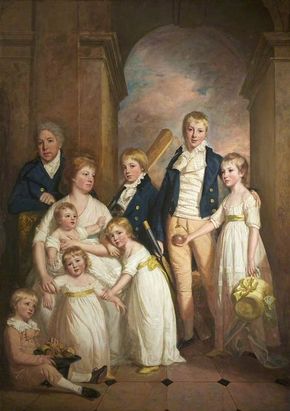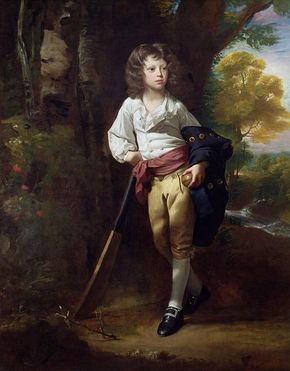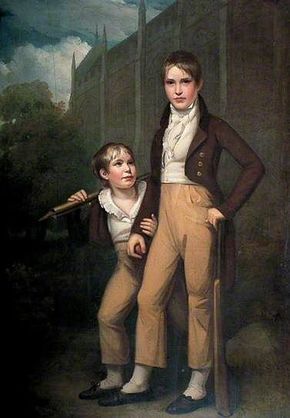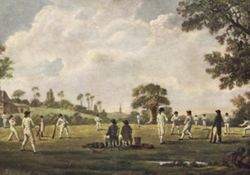Cricket
(I freely confess to having cribbed a lot of this from Wikipedia, with the aim to give an understanding of how the game would have been played in 1811, and therefore how Robbie's players will be playing.)
Cricket is a bat-and-ball game played between two teams of eleven players on a cricket field, at the centre of which is a rectangular 22-yard-long pitch with a wicket (a set of three wooden stumps) at each end. One team bats, attempting to score as many runs as possible, whilst their opponents field. Each phase of play is called an innings. After either ten batsmen have been dismissed or a fixed number of overs have been completed, the innings ends and the two teams then swap roles. The winning team is the one that scores the most runs, including any extras gained, during their innings.
Basic gameplay

At the start of each game, two batsmen and eleven fielders enter the field of play. The play begins when a member of the fielding team, known as the bowler, delivers the ball from one end of the pitch to the other, towards the wicket at that end, in front of which stands one of the batsmen, known as the striker. The striker "takes guard" on a crease drawn on the pitch four feet in front of the wicket. His role is to prevent the ball from hitting the stumps by use of his bat, and simultaneously to strike it well enough to score runs. The other batsman, known as the non-striker, waits at the opposite end of the pitch near the bowler. A dismissed batsman must leave the field, and a teammate replaces him. The bowler's objectives are to prevent the scoring of runs and to dismiss the batsman. An over is a set of four (in 1811) deliveries bowled by the same bowler. The next over is bowled from the other end of the pitch by a different bowler.
The most common forms of dismissal are bowled (when the bowler hits the stumps directly with the ball), leg before wicket (when the batsman prevents the ball from hitting the stumps with his body instead of his bat), and caught (when the batsman hits the ball into the air and it is intercepted by a fielder before touching the ground).
Scoring Runs
Runs are scored by two main methods: either by hitting the ball hard enough for it to cross the boundary, or by the two batsmen swapping ends by each simultaneously running the length of the pitch in opposite directions whilst the fielders are retrieving the ball. If a fielder retrieves the ball quickly enough to put down the wicket with a batsman not having reached the crease at that end of the pitch, that batsman is dismissed (a run-out occurs). Adjudication is performed on the field by two umpires.
Bowling
Bowling in 1811 would be underarm, with the hand rising no higher than the bowler's waist before he released the ball. The rules for bowlers in the 1744 Laws focus on the position of the back foot during delivery (i.e., it had to be behind the bowling crease) and overstepping is the only specified cause for calling a no ball.
Attire
In this period, cricketers generally wore black pumps, white stockings, trousers (commonly worn shorter than modern trousers are worn), shirt and waistcoat. Protective equipment was not worn until about the middle of the nineteenth century.


Cricket in The London Life
Despite being an invalid and unable to play himself, Robbie Fitzgerald has undertaken to organise a game of cricket during his convalescence. So far he has:
- Anthony Dunford, the Duke of Claitonborough
- Blake Pritchard, Marquess of Emerson
- Marcus Fairmont, Marquess of Foxford
- Henry Layton, Earl Parry
- Lord Rotherham (a known good player)
- Rawdon Montgomery, Earl of Alderhan (a confessed poor player)
- Jean-Laurent d'Aubin, Vicomte d'Aubin
- George Hackett, Lord Selwyn
- Victor Kincaide, Viscount Hawksley
- Lord Frank Harpole
- Lord Gabriel Pritchard (a good player)
- Mr Adrian Carey
- Mr Kit Carlisle (a good player)
- Captain Arthur Cartwright
- Sir Perry Bexley
- Sir Will Devenish
- Mr Charlie Devenish
- Mr Julian Freye
- Mr Fred Lazenby (a good player)
- Mr Michael Randal
- Mr Maximilian Sandeford-Wrey
- Mr Geoffrey Stapleton (a poor player)
- Mr Ira Wilson
- Major Gerald Stapleton - to umpire?
- Major Felix Sutcliffe - to umpire?
(Those in italics are on his list of potential players but haven't actually been asked yet. Note: Former characters on the list will be replaced by new characters or NPCs when he has the opportunity to ask them.)
